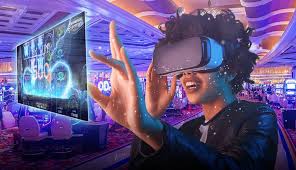You know that feeling of walking into a real casino? The distant clatter of chips, the low hum of conversation, the way the lights from a hundred slot machines create a kind of electric haze. For decades, online casinos tried to replicate that with flashy graphics and sound effects, but it always felt like… well, looking at a picture through a window.
Virtual reality is kicking that window in. It’s not just an upgrade; it’s a fundamental shift. We’re moving from playing a game to inhabiting an experience. Let’s dive into what VR casinos are like right now and, honestly, where they’re headed next. It’s a wild ride.
The Current State of Play: What It’s Actually Like Inside
So, what can you expect from a modern VR casino? Put on a headset like the Meta Quest or Valve Index, and you’re instantly transported. You’re no longer a cursor on a screen. You’re an avatar in a meticulously designed space.
A Feast for the Senses (Well, Almost)
The immersion is the real game-changer. You can walk around a virtual blackjack table, lean in to see your cards, and nod to the dealer. You can look over at the slot machine next to you and see another player’s avatar pulling the lever. The sound is spatial, meaning the chatter of other players fades as you walk away, and the spin of a roulette wheel sounds like it’s right in front of you.
It’s this sensory detail that builds the illusion. You can reach out with your motion controllers and stack your chips, throw the dice in craps, or tap the screen to place a bet. It’s tactile. It’s intuitive. It’s a far cry from just clicking a mouse.
The Social Gambling Experience
This is arguably the biggest draw. Online gambling can be a solitary affair. VR casinos are inherently social. You can talk to other players using voice chat, see their gestures, and even read some body language through their avatars. It recreates the camaraderie—or the competitive tension—of a real casino floor.
Imagine playing a poker tournament where you can actually look your opponent in the eye (or, you know, their avatar’s eye) when you go all-in. That’s a level of psychological gameplay that flat-screen gaming simply cannot deliver.
Hurdles on the Road to Mainstream Adoption
Okay, so it sounds amazing. But why isn’t everyone doing it? Well, there are a few significant speed bumps.
The Cost of Entry
A good VR headset is still a considerable investment. While prices are dropping, it’s a barrier for the casual user. Then there’s the need for a powerful gaming PC for the highest-end experiences. The ecosystem isn’t quite plug-and-play for the average person yet.
Content and Library Limitations
The selection of games, while growing, is still limited compared to traditional online casinos. You might find a few variations of blackjack, roulette, and slots, but the deep catalogs of hundreds or thousands of slot titles aren’t fully translated into VR yet. Developers are playing catch-up.
Comfort and Accessibility
Not everyone can wear a headset for an extended period. Motion sickness, though less common with newer tech, is still a reality for some. And for people with certain physical disabilities, the current controller-based interaction can be a challenge. True accessibility in virtual reality environments is an ongoing development.
The Crystal Ball: Future Developments in VR Gambling
This is where it gets really interesting. The current VR casino is just the prototype. The future developments are poised to blur the line between virtual and real entirely.
Hyper-Realism with Haptics and Beyond
We’re talking about haptic feedback suits that let you feel the weight of chips in your hand or the vibration of a slot machine paying out. Imagine haptic gloves that simulate the texture of a felt table. Or even olfactory tech—controversial, sure—that could introduce the scent of a leather chair or a complimentary cocktail. The goal is total sensory immersion.
The Rise of the Metaverse Casino
VR casinos won’t be isolated destinations. They’ll be integrated into larger metaverse platforms. You might finish a business meeting in a virtual boardroom, then walk your avatar through a digital cityscape to a branded casino resort. These spaces will offer more than gambling: live concerts, sports bars, shopping. The casino becomes one part of a vast, interconnected social and entertainment universe.
Blockchain, NFTs, and True Digital Ownership
This is a huge one. Blockchain technology could allow players to truly own their in-game assets. Think of buying a unique, verifiable NFT of a rare avatar, a special deck of cards, or even a virtual “property” like a VIP lounge table that generates revenue. It introduces a whole new layer of economy and ownership to the virtual gambling experience.
AI-Powered Personalization
The dealers and other players you interact with will become incredibly sophisticated. AI-driven non-player characters (NPCs) will be able to hold natural, dynamic conversations. The environment itself will adapt to you—suggesting games you like, offering personalized bonuses, and creating a truly unique experience for every user.
A Final Thought on the Virtual Frontier
The evolution of virtual reality casinos isn’t just about better graphics. It’s about rebuilding the very concept of a casino from the ground up in a digital space. It’s about connection, immersion, and experiences that are currently confined to our imagination.
The technology is racing forward, and the boundary between visiting a casino and living inside one is getting thinner every day. The question is no longer if VR will redefine online gambling, but how quickly we’ll adapt to a world where the digital felt table feels as real as the one right in front of us.




